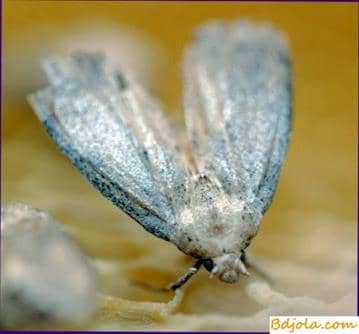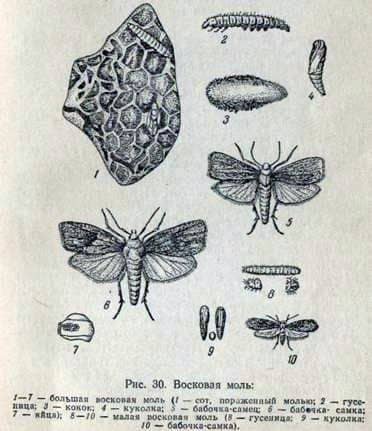Large wax moth

Wax moths are called night butterflies, the caterpillars of which feed on wax. There are two types of moths: large and small.

A large wax moth (moth, clap, Gal-leria mellonella) is a 20 mm long butterfly with a width of 30-35 mm in the wingspan. Fore wings ashy-gray and yellow-brown (to the posterior margin), and hind light gray with dark dashes at the posterior margin. The butterfly’s head has large facetted eyes, tender, easily curved tendrils consisting of 60 segments. Oral organs are underdeveloped. With a slight pressure on the lower part of the torso, the male has a copulatory organ, and the females have an ovipositor.
The male is smaller than the female (16 mm in length), the male’s front wings have a deep notch with a black and thick fringe at the back edge. The head is round. In a calm state, he sits with his wings spread out. In females, the head is elongated, elongated. In a calm state, the wings are kept assembled.
Mating of males and females occurs a few hours after emergence from the cocoons. 2-3 days after mating the female puts 80-100 eggs in the cracks, seams, deepening of the walls and ceiling of the hive, frames or cells of honeycombs. Then he changes his place and puts the same number of eggs in other places. The female lives 26 days and lays 1500-2000 eggs.
Moth eggs are white vitreous, slightly oval, 0.4 mm long, inside they have a black core. In the glued form, the eggs are attached to the litter by adhesive mucus. At a temperature of 30-36 њ eggs develop 8-10 days, and at a lower – 12 days or more. A caterpillar grows from the egg. It is dirty white with a brown head, consists of 13 segments: 3 thoracic and 10 abdominal.
The caterpillar has 8 pairs of short legs: 3 pairs of thoracic (articulate structure), 4 pairs of abdominal (in the form of warts) and a pair
Destroyers of wax structures of bees are only caterpillars of wax moths. The caterpillar, which emerged from the egg on the surface of the honeycomb, soon passes into the side wall of the cell, drills the entrance into it and on the fourth day reaches the mediastinum of the honeycomb, in which it makes exits from both sides of it. The caterpillar tightens its course with cobwebs. The course takes the form of a tunnel in which the caterpillar becomes inaccessible to the bees.
With age, the tunnel increases in diameter, and the yarn of the caterpillar becomes fuller and stronger. In places in the branches there are branches through which the caterpillars expose the posterior end of the body and throw out their feces. Feces of young caterpillars are powdery, in adults – in the form of large balls. They lie in the yarns and in the litter at the bottom of the hive.
An adult caterpillar stops eating, gets into any places protected from bees, for example, into a corner, a crack or a hive stitch, spins a dense cocoon and pupates, often they are close together.
Pupae of large wax moths initially have a white color, and subsequently darken. On the fourth day they acquire a light-brown, and before the exit – a dark-brown color. The pupa of the female has a length of 16 mm, and the male – 14 mm. Development of the pupa lasts about 14 days.
The full cycle of development of a large wax moth at the most favorable temperature of 30-34 њ lasts 66 days, and at a lower one it lasts up to 3-4 months or more. The damage caused to beekeeping by a large wax moth sometimes grows large.
The natural food for moths are nesting honeycombs consisting of wax and chitinous cocoons that are hatched in honeycomb larvae and pupae of honeybees. Each caterpillar consumes about 0.4 g of wax for its full development and spoils 500 or more cells. Most of all, weak families with an extended nest are affected. With a strong defeat of the beehive’s moth, the development of the latter is delayed. Sometimes bee colonies leave the hive because of the strong destruction of the nest.
Wax, consisting mainly of a mixture of esters, high-molecular monohydric acids and alcohols, as well as free alcohols, acids and saturated hydrocarbons, gives carbohydrate food for moths. Nitrogen food is obtained from the chitinous shirts left in the cells by larvae and pupae. The development of moths can also take place in the measure of manual pressing, resulting from the processing of honeycombs into wax. There is still quite a lot of wax in it. However, the moth is not able to fully complete its development cycle in the midst of extractive plants, where the wax is completely extracted. In them, the moth experiences carbohydrate starvation.
The mole can also develop in light nesting cells, in which one or two generations have been removed. But in such cases, the moth experiences protein starvation. When developing in light nesting honeycombs, the larvae of moths replenish the deficiency in the protein by eating chitinous larvae and pupae of bees.
A wax moth gives, in a year 2-4 generations. Theoretically from one pair of moles within a year, offspring up to one billion can be obtained (provided that for a year three generations are deduced and each female lays 1000 eggs each). If 0.4 g of wax is required for the complete development of a single caterpillar, then for a billion caterpillars, making up the annual offspring of one pair of moths, 250 tons of wax would be required. Practically such a rate of reproduction the moth does not reach because of the constant restriction of its development. But in the presence of large reserves of waxy land, the mole develops rapidly and destroys large amounts of wax.
The development of moths strongly limits low temperatures. At a temperature of 10 њ, the mole ceases to develop, and at low temperatures the mole dies in all stages: at -9 њ all the stages of moles die in 2 hours, at -10 њ in 1 hour 30 minutes, at -15 њ for 45 minutes.
Prevention. In the apiary, favorable conditions should be created for the bees, in which they themselves well protect the nest from this parasite. These conditions include the maintenance in the apiary of strong families with a compressed renewable nest covered with bees, abundant feeding, sufficient warming, maintenance in the hives of purity.
Warehouses storage of honeycombs and defective sushi keep clean, air. For the warehouse choose a light, dry room. Storage of honeycombs is practiced open and closed. With open storage, the honeycombs are hung at a distance from each other in a room under the ceiling on special racks. Butterflies moths usually lay eggs between contacting honeycombs, and they avoid open ones. In the case of laying eggs with a butterfly honeycomb, only one can be damaged, while others remain free of moths. With this method of storage, a monthly inspection of the cells is performed.
The closed method is usually used to store store cells, which in hives are only about one month a year, during the main honey collection, and the rest of the time they are stored in warehouses. Closed storage is carried out either in special, tightly knit, well-closed boxes, or in placed on each other beehive casings or magazine extensions. In the last two cases, the bottom is made to the bottom case or shop, and the roof to the top. All the cracks between them are pasted with paper or entirely tied with plastic film. This method keeps the cells from damage by moth.
To avoid skidding with honeycomb moths in the stage of an egg or a young caterpillar at this time conduct a pest control. For such purposes, 50 g of formalin, 150 ml of carbon disulphide or 50 g of paradichlor-gasoline (not toxic for humans, do not ignite) are put into the box, casing or magazine extensions at the rate of 1 m3 of volume. Good results against wax moths allow the dusting of suitable honeycomb and rejected sushi with entobacterin – a microbial preparation that causes the death of wax moth caterpillars. For bees, this drug is harmless.
Control measures. The fight with the moth should be carried out in the apiary and in the warehouses storing honeycombs and wax raw materials. In the apiary, the families affected by the moth are systematically inspected with simultaneous catching and destruction of caterpillars, as well as cleaning the hives of the hive, the upper bars of the frames; contain bees on a compressed nest. Such activities in practice give good results. Exile caterpillars of moths from honeycombs, taken from the hive, reach an easy rapping on the frame. It is also useful to open the motions of moles with a sharp knife, which will allow the bees to clean them and rebuild the destroyed cells anew. Strongly affected honeycombs are removed from the hive and the nest is cut. Families provide sufficient supply of food and are well insulated.
When detecting moths in storage facilities of honeycombs and wax raw materials, the following measures are carried out.
Strongly affected honeycombs, unsuitable for further use, as well as all the wax raw material are re-poured onto wax.
Cells not destroyed by moths and honeycombs, slightly affected, suitable for further use, are subjected to disinsection. Disinsection is carried out in the same way as in the prevention of moths. It can be provided with low temperature. Holding the honeycomb at a temperature of -10 њ kills the mole in all stages for 1 hour and 30 minutes.
Large wax moth
